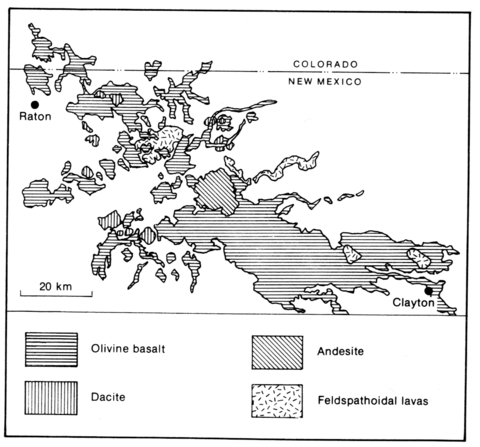stripes
The Raton-Clayton volcanic field covers nearly 2 000 km2 in northeastern New Mexico with a small area extending northwards into Colorado. Some ninety volcanic cones can be distinguished, generally rising above lava flows which are normally basaltic but andesitic and feldspathoidal lavas are abundant, the latter overlying the basalts, in some places unconformably. Phonolite sills occur in the southwestern part of the area, but belong to a period of volcanic activity pre-dating the basalts (Stormer, 1972b, p. 3300). The feldspathoidal lavas are a series of basanitic and nephelinitic flows with analcime, hauyne, nepheline and sometimes melilite. Olivine phenocrysts are always present and augite phenocrysts variably so. Plagioclase is generally restricted to the groundmass in the basanites, as is nepheline, but hauyne may occur as phenocrysts or groundmass; accessories include magnetite, biotite and carbonate, and there is abundant glass in some rocks. Basanite also occurs as plugs and in that at Sombrero Butte (Pittsburg Knob) analcime is the common feldspathoid, but elsewhere it is nepheline (Scott et al., in press). Basanite cinder cones of ash, scoria, bombs and lapilli are also widespread. Phelps et al. (1983) report the presence of ultramafic nodules in a basanite and an olivine-melilite nephelinite flow; websterite, wehrlite and harzburgite are the principal rock types. Trachytes, called the 'Slagle trachytes' by Collins (1949), are restricted to sills in the southwest of the area and consist of alkali feldspar, oligoclase-andesine, an amphibole, possibly sodic, and aegirine-augite (Stobbe, 1949, p. 1072). The Chica phonolites, which form dykes as well as sills, contain 17-52% feldspathoid, mainly nepheline but with plentiful analcime, sometimes as phenocrysts, 28-71% alkali feldspar, 7-22% aegirine and scarce magnetite and sphene; a mineral of the sodalite group is sometimes present as small euhedra. One group of phonolite sills contains leucite. Dykes of vogesite, minette and kersantite are usually thin and short, but one extends for 14.5 km (Scott et al., in press); some contain feldspathoids. Three small diatremes have been identified, two of which contain lamprophyre plugs while the third is kimberlitic with a small area of peridotite (Scott et al., in press). M. H. Staatz (personal communication, 1984) has found one small dyke of carbonatite in the Raton area. Field descriptions and geological maps will be found in Collins (1949) and Baldwin and Muehlberger (1959) and detailed petrographic descriptions in Stobbe (1949). Mineralogical data and rock analyses will be found in Stormer (1972b). Sr isotopic compositions for a range of rocks were determined by Jones et al. (1974). Phelps et al. (1983) give major and trace element whole rock and Nd and Sr isotopic data for basanites, olivine nephelinites and olivine-melilite nephelinites.
BALDWIN, B. and MUEHLBERGER, W.R. 1959. Geologic studies of Union County, New Mexico. Bulletin, Bureau of Mines and Mineral Resources, New Mexico Institute of Mining and Technology, 63: 1-171.
COLLINS, R.F. 1949. Volcanic rocks of northeastern New Mexica. Bulletin of the Geological Society of America, 60: 1017-40.
JONES, L.M., WALKER, R.L. and STORMER, J.C. 1974. Isotope composition of strontium and origin of volcanic rocks of the Raton-Clayton district, northeastern New Mexico. Bulletin of the Geological Society of America, 85: 33-6.
PHELPS, D.W., GUST, D.A. and WOODEN, J.L. 1983. Petrogenesis of the mafic feldspathoidal lavas of the Raton-Clayton volcanic field, New Mexico. Contributions to MIneralogy and Petrology, 84: 182-90.
SCOTT, G.R., WILCOX, R.E. and MEHNERT, H.H. (in press). Geology of volcanic and subvolcanic rocks near Raton, Colfax County, New Mexico. Professional Paper, United States Geological Survey.
STOBBE, H.R. 1949. Petrology of volcanic rocks of northeastern New Mexico. Bulletin of the Geological Society of America, 60: 1041-93.
STORMER, J.C. 1972a. Ages and nature of volcanic activity on the southern high plains, New Mexico and Colorado. Bulletin of the Geological Society of America, 83: 2443-8.
STORMER, J.C. 1972b. Mineralogy and petrology of the Raton-Clayton volcanic field, northeastern New Mexico. Bulletin of the Geological Society of America, 83: 3299-322.
M. H. Staatz, G. R. Scott and R. E. Wilcox, personal communications, 1984.

